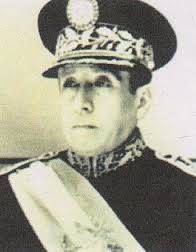Juan Federico Ponce Vaides
| Juan Federico Ponce Vaides | |
|---|---|
 | |
| President of Guatemala | |
|
In office 4 July 1944 – 20 October 1944 | |
| Preceded by | Jorge Ubico y Castañeda |
| Succeeded by | Juan José Arévalo |
| Personal details | |
| Born | 26 August 1889 |
| Died | 16 November 1956 (aged 67) |
| Nationality | Guatemalan |
| Political party | Liberal Party |
| Occupation | Military |
Juan Federico Ponce Vaides (26 August 1889 – 16 November 1956) was the acting President of Guatemala from 4 July 1944 to 20 October 1944. He was overthrown by a popular uprising in October 1944 that began the Guatemalan Revolution.[1]
Jorge Ubico, the dictator of Guatemala from 1931 to 1944 was forced to resign on 1 July 1944 by a popular pro-democracy movement.[2] Ubico appointed three generals, Ponce Vaides, Eduardo Villagran Ariza, and Buenaventura Pineda, to a military junta to succeed him. On 3 July, Ponce Vaides forced the Guatemalan congress at gunpoint to appoint him interim president.[1] Ponce pledged to hold free elections soon, while at the same time suppressing the protests.[2] Freedom of the press was suspended,[2] arbitrary detentions continued, and memorial services for slain revolutionaries were prohibited.[3] However, the protests had grown to the point where the government could not stamp them out, and rural areas also began protesting the dictatorship.[3] The government began to use the police to intimidate the indigenous population to keep it in power through the forthcoming election, resulting in more support for an armed revolution.[3] The army itself had also begun to be disillusioned by the junta, and progressives within it had begun to plot a coup.[3]
On 1 October 1944, Alejandro Cordova, the editor of El Imparcial, the main opposition newspaper, was assassinated. This led to the military coup plotters reaching out to the leaders of the protests, in an attempt to turn the coup into a popular uprising.[3] Ponce Vaides announced elections, but the pro-democracy forces denounced them, citing Ponce Vaides' attempts to rig them in his favor.[3]
Ponce Vaides sought to stabilize his regime by playing on inter-racial tension within the Guatemalan population. The most vocal support for the revolution had come from people of mixed racial descent, or Ladinos.[1] Ponce Vaides sought to exploit their fear of the Indians by paying thousands of indigenous peasants to march in Guatemala city in his support, and promising them land of their own if they supported the Liberal party that Ubico had begun as a front for the dictatorship.[1]
By mid-October, several different plans to overthrow the junta had been set in motion by the various factions of the pro-democracy movement, including the teachers, the students, and the progressive factions of the army.[3] On 19 October, the government learned of one of these conspiracies.[3] The same day, a small group of army officers launched a coup from within the army, led by the coup-plotters Francisco Javier Arana and Jacobo Árbenz Guzmán.[2] They were joined the next day by other factions of the army and the civilian population. Initially, the battle went against the revolutionaries, but after an appeal for support their ranks were swelled by unionists and students, and they eventually subdued the police and the army factions loyal to Ponce Vaides.[3] On October 20, Ponce Vaides surrendered unconditionally.[3]
Ponce Vaides and Ubico were allowed to leave the country safely. The military junta was replaced by another three-person junta consisting of Árbenz, Arana, and an upper-class youth named Jorge Toriello. The junta promised free and open elections to the presidency and the congress, as well as for a constituent assembly.[1] The presidential elections were won by Juan José Arévalo, who began a series of social and economic reforms that constituted the Guatemalan Revolution.[1]
References
- 1 2 3 4 5 6 Gleijeses, Piero (1991). Shattered hope: the Guatemalan revolution and the United States, 1944–1954. Princeton University Press. pp. 26–29. ISBN 978-0-691-02556-8.
- 1 2 3 4 Immerman, Richard H. (1983). The CIA in Guatemala: The Foreign Policy of Intervention. University of Texas Press. pp. 39–42. ISBN 978-0-292-71083-2.
- 1 2 3 4 5 6 7 8 9 10 Forster, Cindy (2001). The time of freedom: campesino workers in Guatemala's October Revolution. University of Pittsburgh Press. pp. 86–89. ISBN 978-0-8229-4162-0.
| Political offices | ||
|---|---|---|
| Preceded by Jorge Ubico |
President of Guatemala 1944 |
Succeeded by Juan José Arévalo |